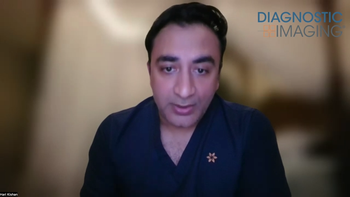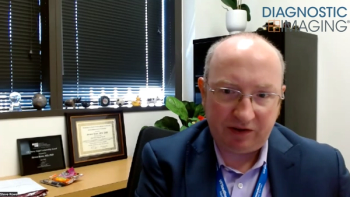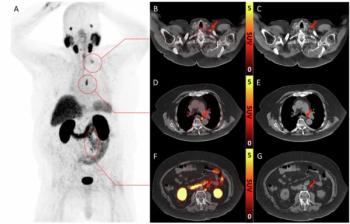
RFA plays role in successful multidisciplinary cancer practice
What does it take to incorporate radiofrequency ablation into a successful cancer practice? Time, money, and skills, to be sure, but also a shift in the way physicians think about modalities, specialties, and the disease itself. The Cancer Care Institute at Decatur Memorial Hospital in Illinois is one practice that has successfully incorporated RFA into its treatment options. Here’s how they did it.
What does it take to incorporate radiofrequency ablation into a successful cancer practice? Time, money, and skills, to be sure, but also a shift in the way physicians think about modalities, specialties, and the disease itself. The Cancer Care Institute at Decatur Memorial Hospital in Illinois is one practice that has successfully incorporated RFA into its treatment options. Here's how they did it.
The Cancer Care Institute embraces a multimodality approach to the disease, with three dedicated interventional radiologists joining nine medical oncologists and five radiation oncologists in the group. This gathering of specialties is prompted by an evolving understanding of cancer, said director Dr. James Lloyd Wade, an oncologist and hematologist.
James L. Wade, M.D.
"The old model of looking at the cancer in the host as a uniform disease, where the whole thing is either getting better or worse, is simplistic," Wade said. "We're beginning to realize that, yes, the disease may be getting worse in some areas, but maybe it can be captured with another modality while we continue to control it in other areas."
Although interventional radiologists are part of the diagnostic imaging department on the organization chart, they work hand in hand with the medical and radiation oncologists to handle cases where a local tumor-control technique may be most effective, Wade said. The oncologists attend the weekly interventional radiology conference, where they present cases and review images, and the radiologists participate in the weekly medical oncology conference.
This emphasis on having a dedicated interventional radiology practice is vital to making RFA and other tumor ablation techniques work both from a patient care perspective and from an economic perspective, said interventional radiologist Dr. Michael Sichlau.
"You need to have an interventionalist who is able to consult, admit, manage, and discharge these patients," Sichlau said. "If you are stuck doing a barium enema and reading a stack of CTs in between rounds and consults and handling crises on the floor, it will never work."
Turf battles aren't an issue in the practice, according to Wade.
"We really don't look at it as a competition for patients. We look at it as an additional level of service we can provide to patients that doesn't exclude our ability to provide the modalities that we think are appropriate," he said. "It's not a competition. It's an extra dimension that we can provide the patients."
The interventional radiologists on the team perform a variety of regional tumor therapies, such as embolization, chemoembolization, and RFA, often in combination. That range enhances both patient care and the bottom line, Sichlau said, as the multimodal ability in the practice leads to referrals from other physicians.
RFA makes up about 30% of the interventional radiology procedures performed. The practice performs RFA on 30 to 50 patients a year, Sichlau said.
Dr. Francis Facchini, a fellow interventional radiologist in the practice, estimates that liver procedures make up about 40% of RFA cases. About 30% of RFA procedures treat bone lesions, 10% treat lung lesions, and 10% treat kidney lesions. The remain 10% of procedures are performed on skeletal, musculoskeletal, or soft-tissue tumors.
Sichlau anticipates that the number of RFA procedures performed will grow. In the last year, he estimates that the volume of renal and lung RFA has at least doubled, while spine RFA has at least tripled. RFA of liver lesions has remained stable.
Michael Sichlau, M.D.
Patients who undergo RFA tend to fall into three broad categories: Those with nonsystemic local disease small enough that it can be eradicated by RF, those who have chemo-insensitive systemic disease or who are ineligible for surgery, and those who can benefit from debulking of a tumor to relieve symptoms.
The costs to incorporate RFA into a practice can be daunting. The generator can cost as much as $30,000 and devices as much as $1000 to $2000 apiece, Facchini said.
But the benefits RFA can bring to a practice can quickly recoup those costs, he said.
"As you do RF, you have the halo effect. As you do interventional cases, it increases the amount of CT, the amount of MR, the amount of ultrasound you do," Facchini said. "If you make a dollar from RF, you make multiple dollars from the halo effect. If you look at the procedure just in and of itself and say I'm only going to look at RF and the economics that are from RF, you need to do 30 or so cases to break even. If you look at the halo effect, it's going to be a lot less - three, four, or five cases. But I choose to look at the fact that it's an incredible thing for patients and patients are happy. They tend to stay at our hospital as a result. When they stay at our hospital, our other doctors continue to take care of them. They don't go elsewhere, they don't go to the university practices outside."
Although both medical oncologists and interventional radiologists endorse the use of RFA for treating selected patients, reimbursement remains an issue. Facchini said about 50% of initial claims for reimbursement for RFA are rejected. Those rejections are usually overturned, however, once the physicians have a change to talk one on one with the physician reviewers.
"We've actually had very good reimbursement on a one-on-one basis," Facchini said. "When these physician reviewers talk to the patients, and the patient says 'I couldn't breath, I couldn't walk, and now I'm feeling good,' it's very hard to deny those payments."
Newsletter
Stay at the forefront of radiology with the Diagnostic Imaging newsletter, delivering the latest news, clinical insights, and imaging advancements for today’s radiologists.






























